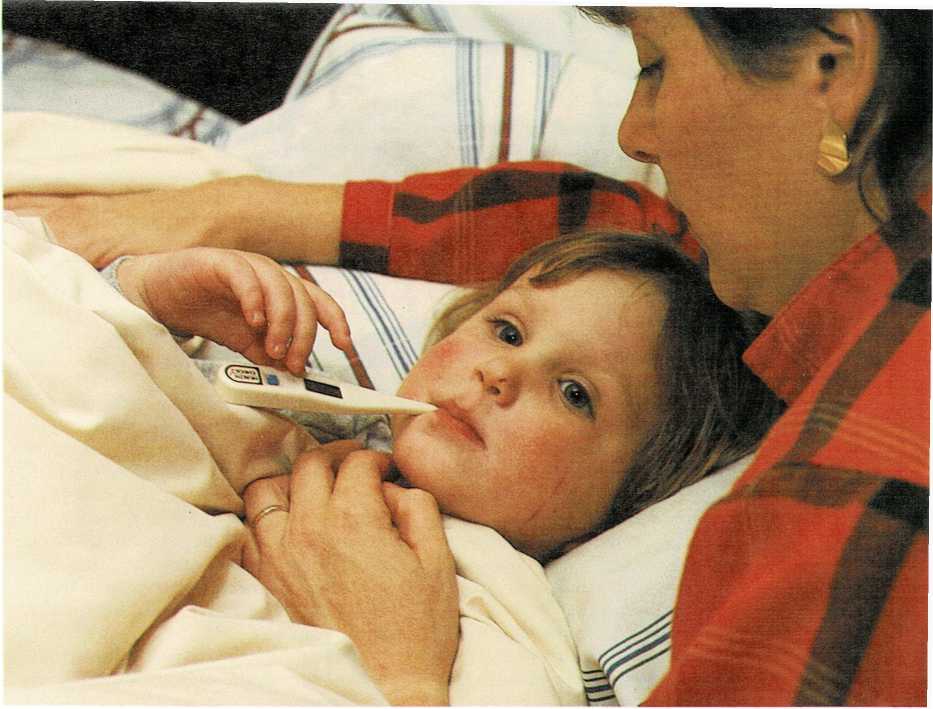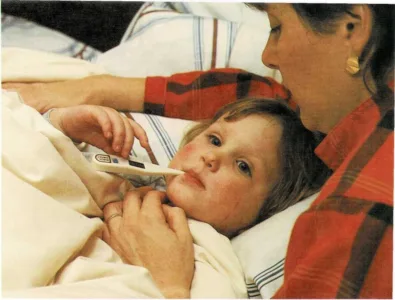Colds – Coma
Colds. Sneezing, a stopped-up or runny nose, sore throat, and a
cough usually are signs of the “common cold,” a malady with which
parents are all too familiar. Children under 2 years old usually get
about 7 colds per year. The number of colds decreases as the child grows
older. Colds may be caused by many different viruses. These viruses are
spread through the air in droplets from sneezes and coughs.
For mild colds with no fever or only a slight fever, you do not have to
call your doctor. However, you should call your doctor if your child has
a fever of 102° F. (39° C) or higher, if there is a fever accompanied by
sore throat, if the cold seems severe, or if the cold lasts more than a
few days.
Because colds may be complicated by ear infections, sinusitis, or other
illnesses, your doctor may prescribe antibiotics to treat such
complications. But the antibiotics have no effect on the cold virus. In
fact, there is no way to cure a cold. All you can do is make the child
as comfortable as possible, follow the doctor’s instructions, and
remember the following points:
**

If your child has a fever of 102° F. (39° C) or higher, or a fever and
a sore throat, call your doctor. Try to make the child as comfortable as
possible.
A child with a cold who does not feel very sick and has only a
slight fever does not have to stay in bed. A child who feels ill may
wish to be in bed.Relieve a child’s fever with an aspirin substitute in doses
appropriate for the child’s age or with other fever medicine
recommended by your doctor.Generally, coughing should not be suppressed. It helps rid the
bronchial tubes and windpipe of mucus and other irritating material.
However, if your child coughs frequently enough to grow tired,
irritates the throat, or cannot sleep, your doctor may want to
prescribe a cough medicine.Increasing the humidity in the child’s room may soothe an inflamed
nose and throat. A cold mist vaporizer should be used.Gently wipe the child’s runny nose to prevent the skin from becoming
chafed. Use nose drops or nasal sprays only when your doctor advises
them. If a baby’s nose is stuffed up, your doctor may recommend
using salt water nose drops and a rubber
syringe to suck the mucus out of the baby’s nose. Salt water for nose
drops can be made by adding 14 teaspoon of salt to 14 cup of warm water.
- Let the child decide if and how much to eat or drink. Do not force
food or liquids on the child.
Infants usually suffer only mild colds—a runny nose and a slight
cough. However, a baby may be very uncomfortable because eating is
difficult when the baby cannot breathe through the nose. A baby also is
more likely to develop middle-ear infections, pneumonia, and other
complications. So anyone with a cold, including members of the immediate
family, should stay away from a baby. If you have a cold and you must
care for a baby, do not breathe directly into the baby’s face. Also,
wash your hands before you handle anything—teething ring, foods, the
bowl of a spoon, toys, nipples—that goes into the baby’s mouth, [m.g.,
s.g.]
See also Allergy; Bronchitis; Communicable diseases; Coughing; Croup:
Drugs; Earaches;
Fever; Hay fever; Humidifying; Laryngitis; Measles; Nose drops;
Pneumonia; Sinusitis; Sneezing; Sore throat; Strep throat; Virus;
Whooping cough
Cold Sore. See Fever blisters
Colic is a common, uncomfortable condition that some babies
experience from the first 2 to 4 weeks of life to the third month.
(Sometimes colic lasts until babies are 6 months old.) These babies cry
hard and seem to be in great discomfort, as if they have a severe
stomachache. Their legs may stiffen, or they may pull them up against
the abdomen.
Often the abdomen is hard and tense, and they may pass gas. Colic occurs
more often in the evening, and, with a few babies, almost every night.
If you think your baby has colic, consult your doctor.
No one is certain what causes most colic. It occurs both in breast-fed
babies and in bottle-fed babies. Some doctors believe that colic is due
to immaturity of the baby’s intestinal tract, because colic almost
always disappears by the time a baby is 3 months old. Colic may be, but
usually is not, caused by allergy.
High-strung babies are more prone to develop the condition than placid
ones. Anxiety or tension in the family may increase the frequency of
colic. Whatever the causes, colic does not interfere with the baby’s
health or development. Here are some of the things you can do to prevent
or lessen your baby’s colic:
If your baby is formula-fed, have your doctor review the formula.
The doctor may want to change it.Check rubber nipples to make sure the holes are the proper size.
Do not feed the baby too rapidly, for too long, or too frequently.
Burp the baby frequently during feedings to release swallowed air.
During an attack of colic, humming, quiet rocking, walking, or
holding the baby firmly against your chest, either wrapped snugly in
a blanket or supported by a pouch, may soothe the baby.Sometimes a colicky baby is more comfort-
able lying on the stomach on a warm hot- water bottle.
- A pacifier often relieves colic.
If the mother is breast-feeding, elimination of such foods as cabbage or
onions from her diet may be tried.
If your baby has colic, have some part- time help, if at all possible,
so that you can take an afternoon nap. An afternoon away from home once
a week may also help. [m.g.]
Colitis is an inflammation of the colon (the large bowel). Colitis
may be either acute (of short duration) or chronic (lasting for a long
time). Consult your doctor if you suspect that your child has colitis.
Acute colitis is a sudden irritation or infection of the colon,
accompanied by diarrhea. Some cases are caused by bacteria, parasites,
and viruses. A child with acute colitis should eat bland foods, drink
plenty of liquids, and rest.
Children with chronic colitis have symptoms either continuously or
recurrently over several weeks or months. There are two common forms of
chronic colitis—ulcerative and mucous, or spastic.
Ulcerative colitis can endanger a child’s life. While doctors do not
know what causes it, they do know how to manage it. The inflamed lining
of the colon bleeds easily and becomes ulcerated. The most common
symptom is diarrhea that may contain mucus and blood. The child may also
have a poor appetite, recurrent abdominal pain, arthritis, fever, and
anemia.
A child with ulcerative colitis may have to be hospitalized. Doctors
prescribe drugs to fight the inflammation and infection. Surgery may be
necessary in extreme cases.
Mucous, or spastic, colitis tends to occur in emotionally sensitive
children. It may be caused by anxiety or other emotional factors.
Symptoms are recurrent abdominal pain and either diarrhea or small, hard
stools.
Regional enteritis (Crohn’s disease) is a long-lasting disease similar
to colitis. Regional enteritis is usually an inflammation of the small
bowel, but the inflammation sometimes extends to the colon. The symptoms
include fever; recurrent abdominal pain,
particularly after eating; diarrhea; constipation; a feeling of rapid
fullness of the stomach at meals; weight loss; and retardation of
growth. Ulceration of the small bowel may cause fistulas (abnormal
channels within the body).
Doctors do not know what causes regional enteritis. Drugs may relieve
the symptoms, but sometimes the inflamed section of the bowel must be
removed surgically, [m g]
Color blindness is an inability to tell certain colors apart. Some
children cannot identify green or red or both. Other children cannot
distinguish between blue and yellow. Only a very few children see all
colors as gray. Some color-blind children fail to recognize pastel
shades.
In most cases, color blindness is inherited. Women are less likely to be
color blind than men are. About 8 out of every 100 men are color blind,
while about 1 of every 200 women is color blind. No cure has yet been
found for color blindness.
Color-blind people often do not realize that their eyesight is defective
because they learn to use the color names that everyone else uses. They
do not realize that they are not seeing the colors as others see them.
If you notice that your 5- or 6-year-old child has difficulty
identifying colors; wears mismatched socks; or cannot take the correct
crayon from a box when asked to select one by color, you should have
your child’s vision checked. [r.o.s.. s.g.]
See also Heredity
Coma is a state of unconsciousness caused by injury, poison, drugs,
or disease. A coma may occur suddenly, or it may be preceded by
confusion, disorientation, or stupor. A coma is always an emergency
situation that demands immediate first aid and immediate medical
attention.
Here are the steps to take if your child goes into a coma:
Be sure that nothing obstructs the child’s breathing.
Lay the child on one side with the mouth open and slightly downward
so that saliva and any vomit may roll out of the mouth.If the child’s tongue falls toward the back of the mouth, pull it
forward. You may have to use a handkerchief or a towel to get a grip
on the tongue.If the child has a convulsion, place a folded handkerchief between
the teeth so that the tongue will not get bitten.Call your doctor. If you cannot reach a doctor, take the child to
the nearest hospital emergency room.
Severe head injury is a common cause of coma. A child may lose
consciousness immediately after the injury or may go into a coma hours
later. Rarely, a child may go into a coma days, or even weeks, later.
Always consult your doctor when your child receives a severe head
injury. The doctor will decide if the child should be hospitalized
immediately or can be cared for safely at home.
If your child is in a coma and you suspect that a poisonous substance
has been swallowed, take the child to a hospital immediately. Also, take
along the container the substance was in to help the doctor identify the
poison and perhaps determine how much the child has taken.
Coma in children may also be caused by a brain hemorrhage, a stroke, a
brain tumor, or drugs. Diseases such as diabetes, meningitis,
encephalitis, Reye’s syndrome, and hepatitis may also cause coma.
A child who is in a coma requires hospital care. Coma is treated
according to its cause. For example, if the coma is caused by diabetes,
the doctor will give the child insulin and fluids, [m.g.]
See also Convulsions; Diabetes mellitus: Fainting; Head injuries;
Meningitis; Poisonings and poisons

